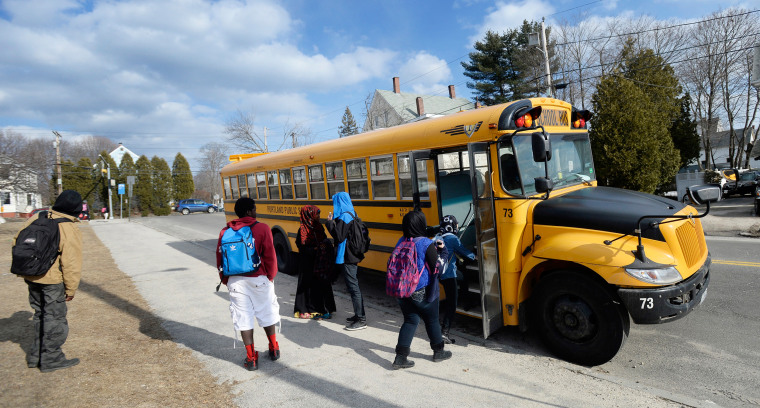As public pressure to enforce civil rights law escalates, the Department of Education released the results of its most recent civil rights investigation today. The subject of the five-year compliance review was the Toledo City School District in Ohio, where Black students make up close to half the K-12 population.
The Department of Education’s Office of Civil Rights routinely screens school agencies for discrimination, in accordance with Title VI of the Civil Rights Act of 1964, which prohibits racial discrimination in federally-funded entities or projects.
While Toledo “has taken several positive steps” to keep education equitable, the investigation “did identify a number of potential Title VI compliance concerns regarding equitable access to resources for African American students, including experienced teachers, teachers with master’s degrees, and library access for K-8 students, and live distance learning classes for high school students,” the report read.
An unrelated Justice Department investigation over disparities in student discipline and provisions for English language-learners is also ongoing.
In 2011, the District launched a transformation plan. Under this plan, 150 teachers and staff were laid off and seven schools were closed, with the remaining schools regrouped into a new elementary-to-high school feeder system.

The OCR chose a statistically representative group of 10 elementary schools and five high schools (of 49 schools total) to study the plan’s effects. It found the District to be racially equitable on a number of measures. Teacher absenteeism was low and evenly distributed. All teachers had at least bachelor’s degrees as required, and more than half had at least master’s degrees. Almost all teachers were properly certified to teach their subject. The District had very few novice teachers – most had been laid off through the transformation plan. At the high school level, highly-qualified teachers were evenly distributed among the schools.
But the school district is largely segregated, with 63 percent of the elementary schools and half of the high schools studied serving either mostly-white or mostly-Black student bodies. Although qualified and effective teachers were evenly distributed among high schools, most of the elementary schools with the highest number of teachers with master’s degrees were white schools; most with the lowest numbers of teachers with master’s degree were Black schools.
All but one of the Black elementary schools studied were underperforming. The exception, Old West End Academy, a magnet school that is 97 percent Black, was among the top five academically performing schools in the 2011-2012 year, and is one of just two elementary schools in Toledo that offers language classes (Spanish and German). Yet, it’s the only school in the District that has been neither rebuilt nor renovated; the OCR’s investigation ranked its physical condition as “average,” and identified several external safety issues.
Although qualified and effective teachers were evenly distributed among high schools, most of the elementary schools with the highest number of teachers with master’s degrees were white schools; most with the lowest numbers of teachers with master’s degree were Black schools.
Jesup W. Scott High School, another Black school, has garnered formal discrimination complaints with the OCR in the past. In 2011, its historic building was the last to be renovated on the inside only, as opposed to being rebuilt.
Access to programs and resources also appeared discriminatory. On average, the Black schools studied had more library books but less scheduled library time, compared to white schools. This is partially because there are only 14 librarians in the District, so the elementary schools in particular rely on volunteers – which were fewer in the Black schools. Librarians are also responsible for recruiting parent volunteers.
The District also offers college prep courses at three of its eight high schools (two racially-diverse schools and one Black school) – students at the other schools may access these classes digitally. At three of the high schools engaged digitally (two Black and one racially-diverse), students had to rely on a non-teaching staff member for in-class assistance. The District was required to replace these staff members with teachers in the 2014-2015 school year, at the OCR’s recommendation. Also, a ProPublica report found that in the 2009-2010 year, Toledo high schools with fewer low-income students offered more AP courses than those with more low-income students.
RELATED: Diversity and Dolls: How One Parent is Teaching about Race
Similarly, the District offers vocational courses in some of its high schools, which students can access regardless of which school they actually attend. But the District does not provide transportation to facilitate this access.
Toledo’s compliance review was a routine Department of Education procedure in which a school’s data is requested and reviewed as a preemptive measure. Formal complaints can also trigger an investigation; in both cases, school districts can agree to changes before an investigation becomes serious and loss of funding becomes a possibility.
Toledo’s agreements went into effect this month, and include:
- Informing students, parents, teachers, and administrators of their civil rights
- Strengthening its systems to evenly distribute qualified teachers and principals throughout the District
- Creating better library schedules for both librarians and volunteers, to improve access at Black and racially-diverse schools
- Ensuring teachers are available for distance learners
- Improving communication with students, parents, and community groups to inform them of resources and also to seek their input on proposed changes
The District must report to the Department of Education on its progress with each of these changes at the end of every year, starting this June.
“Superintendent Romules Durant’s efforts to examine and address racially equitable access to Toledo’s resources is critical to all the district’s students’ academic and long-term success,” said Catherine Lhamon, assistant secretary for civil rights at the Department of Education.
“We applaud and are grateful for his and his board’s leadership toward ensuring that all students receive the opportunity our nation’s civil rights laws promise to them. And we look forward to working with the district to ensure that all terms of this agreement are fully and effectively implemented.”
